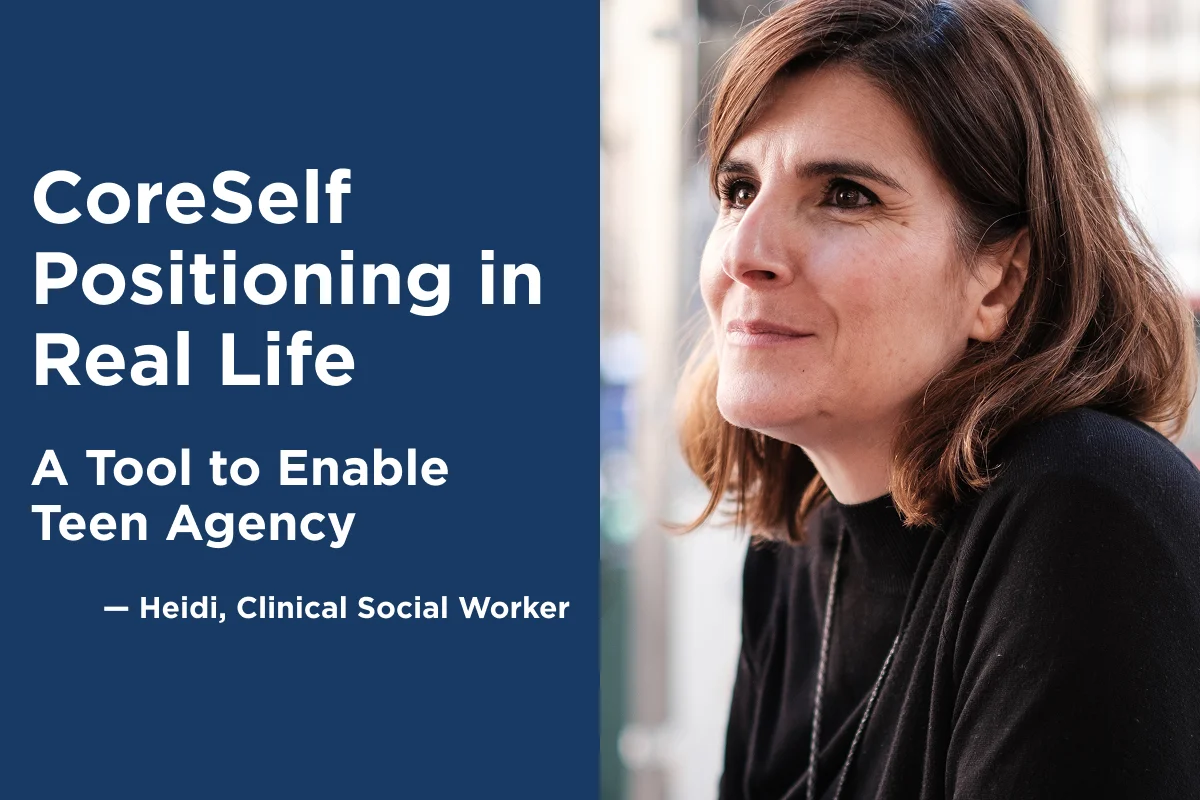A Tool to Enable Teen Agency | CoreSelf Positioning in Real Life

Q&A with Heidi Haas: Guiding Teens and Families with CoreSelf Mapping
CoreSelf Positioning was created to help individuals realign themselves with their own values, acknowledge others needs, and move positively towards the resolution of daily challenges. CoreSelf Mapping, an active writing exercise, is part of the process, and can be critical to unlocking what keeps us “stuck” whether personal or professional.
Heidi is a Licensed Independent Clinical Social Worker (LICSW) and a theater educator. She’s spent years helping young people navigate life’s emotional terrain, and she’s been using CoreSelf Mapping for years. Especially during the pandemic, she saw how much teens were struggling, not just academically, but emotionally, and knew the tool’s potential for deepening the insights from traditional talk therapy.
Q: How did you adapt the process for younger clients?
I adapted a “bicycle” version of the map. The original CoreSelf Map uses circles to represent a person’s inner landscape. In this version, the back wheel represents where you are and where you want to be. The front wheel is about your values and beliefs—what really matters to you. And the handlebars show who or what is pulling you in different directions. It’s a playful yet profound way to visualize the internal journey.
Q: Can you share an example of how this tool helped a teen?
One student was debating whether to stay on the varsity basketball team or switch to track and field. She thought the question was about sports. But the real question was where do I fit in? The map helped her realize she wanted more authentic friendships and room to express herself. She made a big shift, and it changed her entire high school experience.

Q: Have you used the map with families?
Yes, and it’s incredibly powerful. One family with a teen was constantly clashing. When they each created maps, they discovered shared values they hadn’t articulated before. It helped them stop arguing about the surface issues and connect over what really mattered.

Q: What makes this tool so effective?
It gives people access to what they already know deep down but haven’t named yet. Especially for teens, it’s empowering to see their thoughts and values mapped out visually. They realize they have agency.
Q: Any advice for people curious about the tool?
This tool is not just for therapy. It can work for educators, HR leaders, and corporate teams. It’s about understanding who you are, what you value, and how to move forward from a stuck place. And sometimes, just putting it all down on paper makes all the difference.
Q: Can you sum up your experience with CoreSelf Mapping in one word?
Expansive.
Try CoreSelf Mapping for Yourself
Whether you’re a therapist, educator, parent, or someone who works with young people, CoreSelf Mapping offers a fresh, powerful way to spark reflection and clarity. It helps uncover the real questions beneath the surface, questions about identity, direction, and connection. You don’t have to have all the answers. You just need a place to start. This tool creates space to explore, name what matters, and move forward, one thoughtful step at a time. Try CoreSelf Mapping and see what it reveals, not just for those you guide, but for yourself too.
About the Authors
Jonathan Thomas, MSW
Whether at the potter's wheel, coaching medical professionals and teams, or in his private counseling practice, Jonathan Thomas has spent his life molding, shaping and creating something beautiful and new.
Tim Preston
As a successful serial-entrepreneur and angel investor, Tim Preston has spent the majority of his life learning, overcoming, and creating, from blank pieces of paper: self, spaces, teams, and businesses.
Together, Jonathan and Tim founded Simple. Not Easy., LLC, a company that developed CoreSelf Positioning™ tools to help companies and individuals to slow down and align energy levels, values, and actions in order to formulate their best next steps.
Learn more about Jonathan, Tim & CoreSelf Positioning.